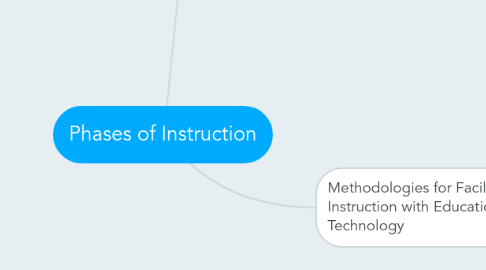
1. 4 phases of instruction that make the process of learning effective and efficient:
1.1. 1. Introduce and Present information
1.2. 2. Guide the learner in using the content/skills
1.3. 3. Practice the content and/or skills
1.4. 4. Assess learning
2. Methodologies for Facilitating Instruction with Educational Technology
2.1. Tutorials
2.2. Hypermedia
2.2.1. are collections of texts, images, audio files, videos, and various combinations thereof that focus on a topic or related set of topics.
2.3. Drills
2.3.1. exists for the third of the phases of instruction: providing practice.
2.3.2. Pitfalls
2.3.2.1. Tend to be boring
2.4. Simulations
2.4.1. model some phenomenon or activity that users learn about through interaction with the simulation.
2.4.2. Advantages
2.4.2.1. Saftey
2.4.2.2. Modification of time frames
2.4.2.3. Making rare events more common
2.4.2.4. Controlling the complexity of a phenomenon
2.4.2.5. Enhancement of motivation to learn
2.4.2.6. Transfer of learning
2.5. Educational games
2.5.1. Depending on the structure of the games, they can be used for all phases of instruction.
2.5.2. Advantages
2.5.2.1. Motivation to learn
2.5.2.2. Students tend to invest a lot of cognitive effort when playing games
2.5.2.3. Develop knowledge and skills
2.5.2.4. Depending on the structure, they can develop collaborative skills
2.5.3. Pitfalls
2.5.3.1. can instigate debilitating levels of competition
2.5.3.2. rely too much on chance instead of knowledge or skills
2.5.3.3. difficult to balance between educational goals and various characteristics of games
2.6. Tools and Open-ended Learning Environments
2.6.1. reflect a constructivist approach to learning
2.6.2. emphasize learning by discovery and exploration, problem solving, and by teaching things to the computer or other students
2.6.3. Advantages
2.6.3.1. Deep learning and transfer
2.6.3.2. Collaborative learning
2.6.3.3. Motivation
2.6.3.4. Cross curricular learning
2.6.4. Pitfalls
2.6.4.1. Not suitable for all learners
2.6.4.2. Some teachers are unable to adapt to new roles
2.6.4.3. Assessment and evaluation of learning can be difficult
2.6.4.4. Large investment of instructor and student time

